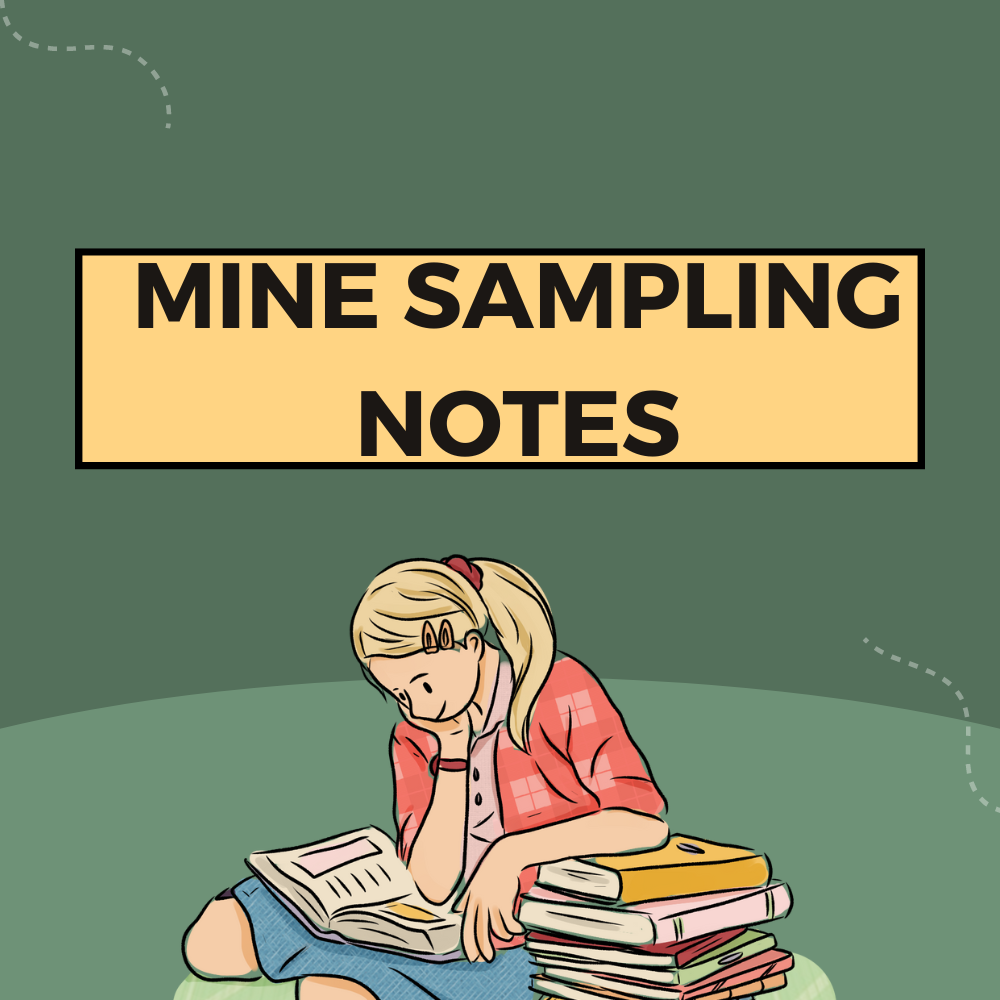
MINE SAMPLING NOTES
Theory
Mine sampling is a
critical process in the mining industry, ensuring that the quality and quantity
of mineral resources are accurately assessed. The primary objective is to obtain
representative samples that provide reliable data for decision-making in
exploration, development, and production.
1. Purpose of Mine Sampling
- Resource Estimation: To determine the grade and volume of mineral
deposits.
- Quality Control: To ensure consistency and quality of the ore
extracted.
- Economic Evaluation: To assess the viability and profitability of
mining operations.
2. Sampling Principles
- Representativeness: Samples must accurately reflect the material
being sampled.
- Homogeneity: The degree to which the sample material is
uniform.
- Randomness: Ensuring samples are taken in an unbiased manner.
- Reproducibility: The ability to obtain consistent results
from repeated sampling.
3. Sample Preparation and
Analysis
- Crushing and Grinding: Reducing sample size to a manageable level
while ensuring representativeness.
- Splitting: Dividing samples into smaller, equally
representative portions.
- Assaying: Chemical analysis to determine the content of
specific elements or minerals.
4. Quality Assurance and
Quality Control (QA/QC)
- Standard Operating Procedures (SOPs): Ensuring consistency in sampling processes.
- Duplicate Samples: Collecting and analyzing duplicate samples
to check for consistency.
- Blanks and Standards: Using known reference materials to check for
contamination and accuracy.
5. Challenges in Mine
Sampling
- Heterogeneity of Ore Bodies: Variability in ore composition and
distribution.
- Sampling Bias: Errors introduced by non-representative
sampling techniques.
- Sample Contamination: Unintended inclusion of foreign materials
affecting sample purity.
Method
1. Channel Sampling:
- Description: Involves cutting a groove or channel across a rock
face, often in ore bodies.
- Procedure: A consistent, measured volume of material is
removed from the channel, ensuring representative sampling.
- Applications: Suitable for stratified deposits and when
accurate horizontal and vertical sampling is necessary.
- Advantages: Provides a continuous sample that can reveal
variations in ore grade.
- Disadvantages: Labor-intensive and time-consumer
2. Chip Sampling:
- Description: Small pieces of rock or ore are chipped off a rock
face at regular intervals.
- Procedure: Systematic collection of chips, usually from a grid
or along a line.
- Applications: Used in exploration phases and where the rock
face is irregular.
- Advantages: Quick and less labor-intensive than channel
sampling.
- Disadvantages: Less accurate and may not be representative
if not done systematically.
3. Grab Sampling:
- Description: Random collection of ore or rock fragments from a
muck pile or surface exposure.
- Procedure: Ore fragments are collected without a systematic
approach.
- Applications: Often used in early exploration stages or for
quick checks.
- Advantages: Very quick and easy to perform.
- Disadvantages: Highly unreliable and non-representative.
4. Bulk Sampling:
- Description: Large volumes of material are collected to obtain a
representative sample.
- Procedure: Large sample sizes, often several tons, are
collected and then processed.
- Applications: Used to assess the ore grade and
metallurgical properties on a larger scale.
- Advantages: Provides a more comprehensive understanding of the
ore body.
- Disadvantages: Expensive, time-consuming, and requires
substantial logistical support.
5. Diamond Drilling:
- Description: Core samples are extracted using a diamond-tipped
drill.
- Procedure: A cylindrical core of rock is drilled out and
brought to the surface for examination.
- Applications: Deep sampling and exploration, providing
continuous cores for detailed analysis.
- Advantages: Offers a continuous sample that can be studied for
geological features and ore grade.
- Disadvantages: Expensive and requires specialized equipment
and personnel.
6. Reverse Circulation
(RC) Drilling:
- Description: Uses a dual-walled drill pipe to bring rock
cuttings to the surface.
- Procedure: Air is pumped down the outer pipe, and rock
cuttings are brought up through the inner pipe.
- Applications: Exploration drilling where rapid and
cost-effective sampling is required.
- Advantages: Faster and cheaper than diamond drilling, provides
large volume samples.
- Disadvantages: Provides rock cuttings rather than intact
cores, limiting geological detail.
7. Auger Sampling:
- Description: Uses a helical screw to bring soil and rock
fragments to the surface.
- Procedure: Auger drills into the ground, lifting material to
the surface.
- Applications: Suitable for shallow, soft, and
unconsolidated deposits.
- Advantages: Quick and relatively inexpensive.
- Disadvantages: Limited depth and may not penetrate hard rock
formations.
1. Definition and
Purpose:
Mine sampling reductions
involve the systematic process of reducing the volume of a sample while
maintaining its representativeness for analysis. This process is crucial for
efficient handling, analysis, and accurate estimation of ore quality and
quantity.
2. Stages of Sample
Reduction:
- Primary Sampling: Initial collection of a large, bulk sample
from the mining site.
- Secondary Sampling: Further reduction of the primary sample to a
manageable size for transportation and laboratory analysis.
- Tertiary Sampling: Fine-tuning the sample size to ensure it
represents the entire bulk accurately.
3. Techniques:
- Coning and Quartering: The sample is poured into a cone, flattened,
divided into quarters, and two opposite quarters are discarded. The
remaining quarters are recombined and the process is repeated until the
desired sample size is achieved.
- Riffle Splitting: The sample is passed through a riffle
splitter, which divides it into equal parts, ensuring each part is
representative of the whole.
- Rotary Splitting: The sample is fed into a rotating device that
evenly distributes the material into multiple containers.
4. Importance:
- Accuracy: Ensures that the reduced sample accurately
represents the bulk material.
- Efficiency: Reduces the amount of material that needs to be
transported and analyzed.
- Cost-Effective: Minimizes laboratory costs by reducing the
volume of material that needs detailed analysis.
5. Factors Affecting
Sample Reduction:
- Sample Size: Larger initial samples may require more stages of
reduction.
- Material Heterogeneity: Uniform materials are easier to reduce
accurately than heterogeneous materials.
- Reduction Method: The chosen method must suit the material type
and desired sample size.
6. Challenges:
- Bias: Improper sampling techniques can introduce bias,
leading to inaccurate results.
- Contamination: Care must be taken to avoid contamination
during the reduction process.
- Losses: Minimizing losses of fine particles is critical to
maintain sample integrity.
8. Applications:
- Exploration: Helps in estimating the ore reserves and planning
further exploration activities.
- Quality Control: Used in routine checks to monitor the quality
of the extracted ore.
- Resource Estimation: Aids in the accurate calculation of the
quantity and quality of mineable material.


No comments added yet!